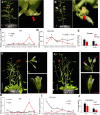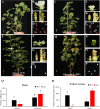GhAOS integrates circadian rhythm and jasmonic acid signaling to regulate high temperature stress responses in cotton and Arabidopsis
- PMID: 41057838
- PMCID: PMC12506428
- DOI: 10.1186/s12915-025-02406-5
GhAOS integrates circadian rhythm and jasmonic acid signaling to regulate high temperature stress responses in cotton and Arabidopsis
Abstract
Background: Cotton (Gossypium spp.) cultivation is significantly challenged by high temperatures (HT), especially during reproductive stages, leading to male abortion and yield losses.
Results: This study investigated the complex interplay between circadian rhythm (CR), HT, and jasmonic acid (JA) signaling in cotton and Arabidopsis. Disruption of CR led to reduced JA content, triggering bud yellowing and abscission at the tetrad stage (TS) in the HT-sensitive cotton line H05 and longer stigma in Arabidopsis. To elucidate the role of JA under continuous light (CL), targeting the JA biosynthesis gene GhAOS in cotton and using Arabidopsis mutants aos and aoc2 revealed accelerated drying, decreased JA content, and male sterility, alongside altered expression patterns of pivotal bioclock-associated genes (PRR1 and LHY). Additionally, mutant anthers manifested elevated ion leakage and H2O2 levels, coupled with reduced activities of antioxidant enzymes SOD and POD during CL + HT stress.
Conclusions: Current study investigated the complex interplay between CR, HT, and JA signaling pathways in cotton and Arabidopsis, focusing on their impact on male fertility under HT stress. These findings highlight the importance of JA and CR in plant fitness, crucial for future crop improvement and sustainable agriculture.
Keywords: Gossypium hirsutum; Circadian rhythm; High temperature stress; Jasmonic acid signaling.
© 2025. The Author(s).
Conflict of interest statement
Declarations. Ethics approval and consent to participate: Ethical approval was not required for this study. Consent for publication: No individual personal data is included. Competing interests: The authors declare no competing interests.
Figures






References
-
- Saini DK, Impa SM, McCallister D, Patil GB, Abidi N, Ritchie G, et al. High day and night temperatures impact on cotton yield and quality current status and future research direction. J Cotton Res. 2023;6(1):16. 10.1186/s42397-023-00154-x.
-
- Khan AH, Ma Y, Wu Y, Akbar A, Shaban M, Ullah A, et al. High-temperature stress suppresses allene oxide cyclase 2 and causes male sterility in cotton by disrupting jasmonic acid signaling. Crop J. 2023;11(1):33–45. 10.1016/j.cj.2022.05.009.
MeSH terms
Substances
Grants and funding
- 2021M701357/China Postdoctoral Science Foundation
- BPN/ULM/2022/1/00147/U/00001/Polish National Agency for Academic Exchange (NAWA) under the Ulam Program
- xjnkywdzc-2025002-14/Project of Fund for Stable Support to Agricultural Sci-Tech Renovation
- 2023ZD040403/Biological Breeding of Stress Tolerant and High Yield Cotton Varieties
- 2023A01/Finance Science and Technology Project of Xinjiang Uyghur Autonomous Region
LinkOut - more resources
Full Text Sources
Miscellaneous

